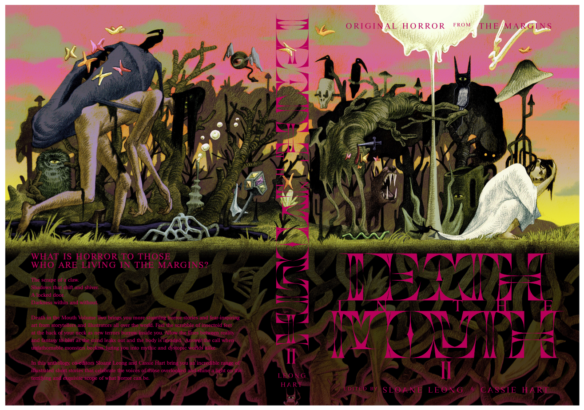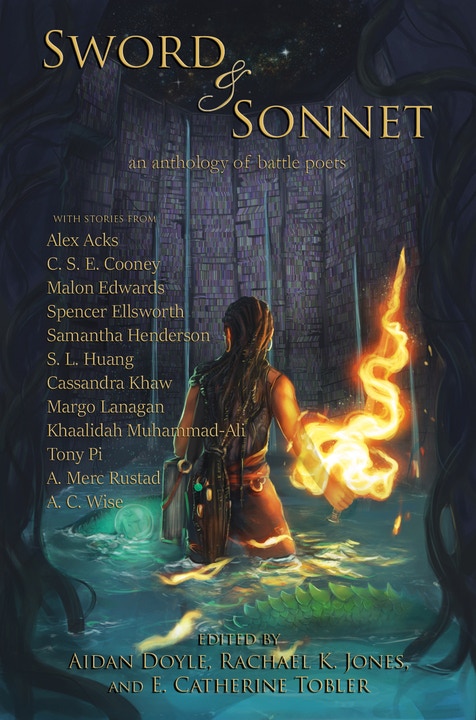(1) RACHAEL K. JONES Q&A. Oregon Public Broadcasting interviewed awards nominee Rachael K. Jones: “Beaverton author is announced as finalist for literary awards”.
Marshall: This short story, “The Sound of Children Screaming,” drew inspiration from real life events, including one that involved you. Can you talk more about that?
Jones: It was one of the more scary experiences in my career in education. I’m a speech language pathologist, which is someone who works in special education with children who have communication disorders.
There was a lockdown at my school that happened during prep planning, which is the week before the school opens for children. All the teachers are in the building. We’re getting our classrooms ready and we’re getting the space ready for children. One evening I stayed late to finish building some Ikea furniture. While I was getting ready to leave the building you could hear weird sounds outside the school, little popping sounds.
The secretary called a lockdown of the whole school. It turned out that there was a shooting happening in the neighborhood. I went back and had to hide under my desk in my office with all the blinds drawn on a Friday night. I’m really grateful there weren’t any children in the building, but the most disturbing thing was that, because there were no children in the building, I knew it couldn’t be a drill. I was really scared.
It was one of those moments where we all tell ourselves stories in our own heads about what we would do in an emergency situation. With school shootings, you have a fantasy about how you’re gonna block the door, throw that stapler over there or tackle the guy and how you’re going to be this hero in your imagination. It was this really chilling moment to realize that this could be it. And what am I doing? I’m hiding under my desk and I’m not any more heroic than I usually am. I could die tonight on a Friday night at my job and that would be that, and there would be nothing I could do about it.
A lot of times I use my stories as a way to process strong feelings, I can’t really get out in any other way. For me, the story represents that kind of story where it says the things that are hard for me to say in any other way than fiction….
(2) TAKE THE AUTOBAHN TO THE CON. Cora Buhlert went to a German Masters of the Universe convention in May and posted a three-part con report with many photos. To get there required a three hour road trip:
…Last Saturday, I attended the 2024 Los Amigos Masters of the Universe fan convention. There are two big Masters of the Universe conventions in Germany, Grayskull Con and Los Amigos, plus at least two general toy cons which attract a lot of Masters of Universe fans and collectors.
Last year, I considered going to one or more of those cons. However, there was one problem or rather two, a) I live in North Germany and most German cons, whether general SFF or specialty cons, are much further south and quite far away, and b) I had sick parents at home and/or in hospital and didn’t really want to leave them alone. Since point b) is no longer an issue, there was only point a) to consider.
Until last year, the Los Amigos convention used to take place in Hanau near Frankfurt, which is a four-and-a-half-hour drive away (or a one-hour flight to Frankfurt and then a train ride to Hanau). However, for 2024 the convention relocated to Neuss, a city in the Rhine-Ruhr metropolitan region, which is somewhat closer, though still roughly three hundred kilometers away, which means a three-to-three-and-a-half-hour drive, depending on traffic conditions….
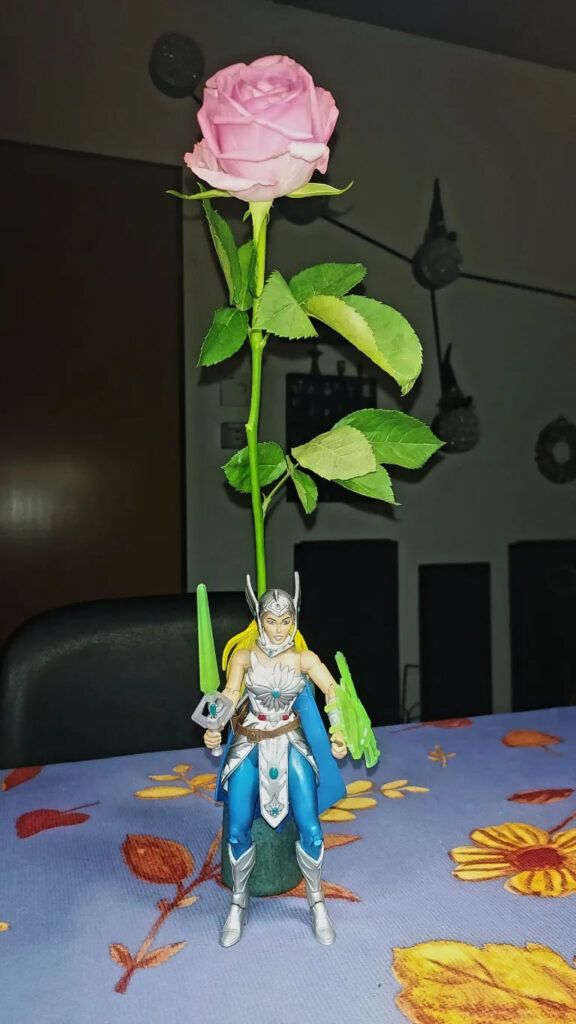
…In fact, there were quite a few customisers were displaying their creations, sometimes for sale, sometimes not. One stall offered a regular Origins Battle Cat customised to look like Battle Cat might have looked, if he had appeared in the 1987 live action movie (he didn’t, because the production team couldn’t make him work with 1980s tech). That Battle Cat looked great, but he was also quite expensive – 130 Euros – and there was so much to buy, so I passed on him. Besides, the Battle Cat was in Origins scale, but the movie figures Mattel is currently making are the bigger Masterverse figures, so the movie style Battle Cat wouldn’t fit in with my movie figure….
… I also learned that Tecklenburg has a castle ruin, as the name implies, and that bits and pieces of the castle have been integrated into buildings all over town. The ruined castle now houses an open air theater – the largest in all of Germany. The open air theater opened in 1924 and is hugely important for the town, since it’s a major tourist draw. The local handyman frequently builds sets and backdrops for them. The theatre used to stage everything from boulevard comedies to operas, but nowadays they most do musicals and children’s plays, because those are the most popular. They also host pop concerts on occasion. This summer, the open air theater Tecklenburg is staging Mamma Mia!, Madagascar (based on the eponymous CGI animated kids film) and a musical version of The Three Musketeers. Personally, I’d prefer operas and operettas or regular plays (Shakespeare should be great on an open air stage in the middle of a ruined castle), but money talks and musicals are popular with people who’d otherwise never watch musical theater or otherwise set foot inside a theater….
(3) HELP WANTED. Cora also has written a recruitment ad parody for the Evil Horde, which is one of the main villain groups in Masters of the Universe and a remarkably diverse bunch. Many positions are immediately open! “Join the Horde! Conquer the Universe! Sign Up Now!”
Are you dissatisfied with harassing peasants and raiding space tramp freighters? Are looking for a new challenge? Do want to see the galaxy and help to subjugate it? Do you want to become part of something greater? Then join the Mighty, All-Conquering Horde.
The Horde Empire is seeking, at the earliest possible date….
(4) KAIJU KORNER. Camestros Felapton is among those dialing up Netflix this week to see “Godzilla Minus One”.
…So firstly, if you are a fan of kaiju stomping and chomping their way through populated cities and military forces who foolishly think their puny weapons can stop the rampaging monster then this film absolutely delivers. Godzilla bites through warships, stomps on buildings and blasts all and sundry with atomic breath. Have no worries in this regard, if that is what you want from a Godzilla film, you should be satisfied. If you want Godzilla to be the misunderstood hero who battles a much worse kaiju, then no, you won’t get that but otherwise this is a solid entry in kaiju mayhem….
(5) MARYANN HARRIS (1953-2024). MaryAnn Harris, wife of Charles de Lint, who had been hospitalized and on a ventilator since 2021 after contracting Powassan virus, an extremely rare tick-bourne illness, died June 3. De Lint made the announcement on Facebook:
I’m so so sorry to have to tell you all that Mare passed away this afternoon, June 3, 2024. She fought long and hard to try to beat the awful state in which the Powasssan virus had left her but in the end she just didn’t have the strength to carry on any longer. She died peacefully in her room, surrounded by family, in the beautiful space that her friends and family made of what had been a sterile hospital room.
She touched the hearts of every one she met and we were all so blessed to have known her.
Lately I’d been wondering what this day would feel like. I’ve been on my own since September 2021 and feel that I started grieving at that point, but all that time did nothing to prepare me for how desolate I feel now that she’s actually gone.
Thanks to everyone who cheered her on through this journey, who sent her cards and little gifts, donations towards her care and all the love and words of encouragement. That did much to carry her forward with strength and determination until her body finally gave out on her.
Words can’t express how grateful we are for your support.
(6) TODAY’S BIRTHDAY.
[Compiled by Paul Weimer.]
June 4, 1960 — Kristine Kathryn Rusch, 64.
By Paul Weimer: For me, Kristine Kathryn Rusch’s diverse and large oeuvre, in my reading, runs along two main tracks.
Where I first discovered and encountered her work was in the boom fantasy period in the 90’s with her Fey series. The Fey novels were my first experience with a robust and expansionistic version of Elves. Up until reading The Sacrifice, The Changling and its sequels, my impression of Elves as I had read them to that point were Tolkienistic: hermit kingdoms, quietly holding their power, or slowly fading away, or looking for the chance to slip away and head west to somewhere over the sea. Elves “belonged” to a world that had passed them by. Imagine my surprise when I started reading the Changeling, and discovered a Elf-like race, the Fey, who were not retiring quietly. Instead, these Fey had decided to conquer the entire world with their battle magic. Sure, Blue Isle proved to be an insurmountable roadblock to those conquests, but the very idea of militant expansionist elves…well, I’ve read takes on it since then in various guises and authors, but Rusch’s Fey were the first time I had ever encountered the idea.

The Wreck series was not quite as innovative for me, but it sits in a relatively unexploited portion of space opera: Space Archaeology. Boss’ story, in Diving into the Wreck and its sequels, is the story of a character whom, when I met her, thought, “Hey, that would make a neat Traveller character– someone who plunders old spaceships for a living, especially for their history, as well as for the financial aspects of same. I’d read McDevitt, and Modesitt, and other authors which explored Xenoarchaeology before running into Boss, but Boss was and is a one-of-a-kind character, larger than life. I can always tell that a character resonates with me when I want to make an expy of that character for a RPG. Boss and her adventures in the first couple of novels wanted me to do that. I didn’t quite as warm to the other various characters, such as Coop, in the later Diving novels, but maybe that’s because Boss so firmly imprinted on me that she ate up the space for me to do so.
But in the end, Rusch has a prodigious output, under a variety of pen names, in a wide variety of subgenres from tie-in novels to romance, and thus is one of those authors you could lose yourself in her massive oeuvre and not come out for months or years.
(7) COMICS SECTION.
- Thatababy reports something that once was commonly known
- Bizarro shows why they’re a perfect match.
- Macanudo has an expert taster.
- Pearls Before Swine wistfully remembers a social media platform. (Wait, it’s still here!)
(8) BASED ON AN OCCASIONALLY TRUE STORY. [Item by Cora Buhlert.] ROH Press published an interesting profile about the Italian adventure fiction writer Emilio Salgari (1862-1911), who created Sandokan, the Tiger of Malaysia, and the Black Corsair. Salgari isn’t very well known in the US, but I encountered his work via the film adaptations which were a staple of afternoon TV, when I was a kid: “Emilio Salgari: Master of Adventure”
…He claimed to have travelled throughout the American West where he met Buffalo Bill; he had explored the Sudan, lived at the Mahdi’s court, loved Indian princesses, sailed among the many islands of the Far East. Here was a man of action that had explored the world and lived many adventures, adventures he would use for the basis of his 80 plus novels and hundreds of short stories to captivate readers worldwide. At dinner parties he regaled his hosts with tales from his many voyages, guests to his home would often be shown artefacts acquired in far off lands. Throughout the 20th century illustrations of him on the back of his novels showed him clad in his captain’s uniform. His memoirs were filled with adventures in the most exotic lands. A remarkable life, envied by many.
Except that very little of it was true. He did meet Buffalo Bill, but at Sherman’s Wild West Show in Verona, not, as he claimed, while exploring Nebraska. He was knighted for his stories, that much was true; he founded the adventure genre in Italy, his tales captivating young and old, and inspiring many to take up the pen….
(9) NO SUCH THING. [Item by Cora Buhlert.] This is a year old, but it’s still a lovely remembrance of Manly Wade Wellman from Stephen Smith who was one of his creative writing students: “Manly Wade Wellman: Our Forgotten Man of Letters” in The Pilot.
…Wellman was fiercely proud of his stature as a writer. “Outlaws,” he called us, generously including his students in the designation, and he had the rare ability, from the moment he stepped into the room, to instill in each student the strong belief in self that made him a successful writer and a charismatic presence.
Each Tuesday morning that semester, I’d drop a story in the campus mail, and Manly would critique and correct it and hand it back after reading it aloud to the class. I was no doubt an annoyingly eager student, and on a couple of occasions I submitted two stories in one week. “You’re like the tiger who’s tasted blood,” Manly laughed — and in fact, I was spending entirely too much study time writing fiction. Not all my stories were keepers, but one was good enough to win a state-wide short story contest that earned me $100 and a magazine publication. When I met with Manly after winning the magazine prize, he asked what my major was. I told him it was sociology. “Change your major to English!” he barked. “There’s no such thing as sociology!”…
(10) WILL SPIELBERG ADAPT ANOTHER CHICHTON NOVEL? “Eruption: James Patterson finishes Crichton passion project” – and the BBC says now that it’s done Hollywood is abuzz.
Jurassic Park author Michael Crichton died from cancer over 15 years ago – now, his unfinished “passion project”, about a humanity-threatening volcanic eruption, has been completed by fellow literary giant James Patterson and is already generating heated interest in Hollywood.
Eruption takes readers on a thrilling journey through Hawaii’s biggest island, which, unbeknown to its residents, hides dangerous military secrets dating back decades.
There has been no formal screen auction yet – but Sherri Crichton, who discovered her late husband’s unfinished manuscript over a decade ago and controls his estate, told BBC News she was now in talks with Steven Spielberg about a possible big-screen adaptation.
(11) LE GUIN LOOKS IN THE MIRROR. B.D. McClay’s article “Ursula K. Le Guin was her own toughest (and best) critic” is behind a Washington Post paywall. If you have access, lucky you!
… What a pleasure it is, then, to open “The Language of the Night: Essays on Writing, Science Fiction, and Fantasy,” and discover someone vigorously disagreeing with herself on almost every page. To say that the Le Guin we meet in this book is argumentative, sometimes unfair, sometimes wrong and even self-contradictory is not to diminish her greatness. It is rather to rescue her from the dullness imposed on her by her canonization.
By her own account, Le Guin was an indiscriminate reader of books at a young age; she read science fiction, but with no particular devotion. As she got older, the genre did not seem to have a place in it for an adult. “If I glanced at a magazine,” she wrote in the essay “A Citizen of Mondath,” included in this collection, “it still seemed to be all about starship captains in black with lean rugged faces and a lot of fancy artillery.” She drifted off to “Tolstoy and things,” and it was only when a friend told her to read a short story by Cordwainer Smith that she went back to science fiction.
Smith — whose real name was the somehow even more improbable Paul Myron Anthony Linebarger — worked for the United States military; he was, perhaps, too close to war to fantasize about it. He drew imaginatively from other sources, like Joan of Arc and Chinese mythology. His work, which features psychic pilots and heroic space cats, is elastic, wild and, perhaps most importantly in seeing his influence on Le Guin, very funny.
For Le Guin, who was also uninspired by military aesthetics, similarly eclectic in her influences and would complain that nobody ever noticed when she was being funny, reading Smith must have been a shock of recognition akin to love at first sight. (“I don’t really remember what I thought when I read it,” she wrote, “but what I think now I ought to have thought when I read it is My God! It can be done!”) …
(12) JMS Q&A. Also behind a paywall (it’s not our lucky day!) is the Los Angeles Times’ interview with J. Michael Straczynski about his work preserving Harlan Ellison’s legacy: “Harlan Ellison’s books being reissued by J. Michael Straczynski” This passage talks about the façade of Ellison’s home dubbed “The Lost Aztec Temple of Mars”.
On a hilly street in Sherman Oaks, writer and producer J. Michael “Joe” Straczynski gestures to a row of gray gargoylesque heads mounted above an entryway. “If you look carefully, you’ll see they are the Watergate figures,” he says. “Nixon in the middle, surrounded by Mitchell, Dean, Haldeman, all of them.” He smiles, knowing that the mind that created this funky tableau belonged to none other than his closest friend, the eccentric author of speculative fiction, Harlan Ellison….
…. The Watergate grotesques form a small portion of the weird and sometimes wacky, but always carefully curated, world of Ellison. The largest portion of the facade features stone-intaglio pictographs that at first glance might be Egyptian hieroglyphs or Aztec sun symbols; closer examination reveals all sorts of imaginative creatures, from tiny robots to taloned divinities to monsters. Every piece of the house was carefully chosen by Ellison, and many pieces, including carved doors, staircases and even hinges and handles, were designed to his specifications. Next to the doorbell hangs a small framed sign: “Dig. Or split.” The author had no interest in catering to people who did not share his enthusiasms or worldviews….
(13) JUSTWATCH TOP 10S FOR MAY. JustWatch has shared their Top 10 streaming charts for the month of May.
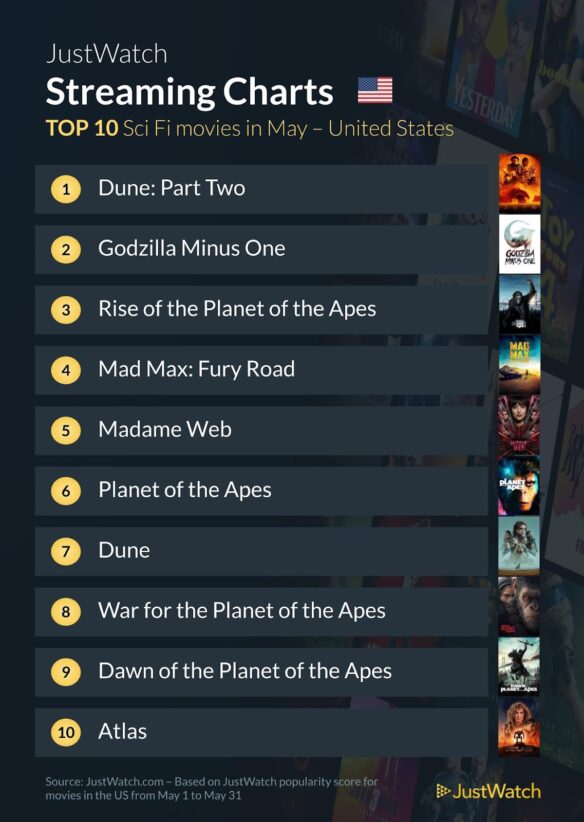
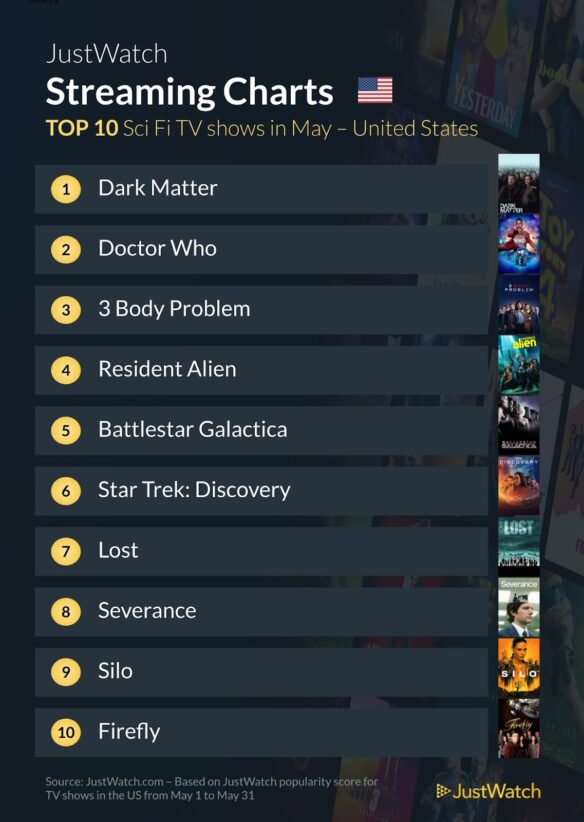
(14) HOMEWARD BOUND FROM LUNA. “China moon landing: Spacecraft Chang’e-6 unfurls flag on far side of the moon” – AP News has the details.
…The Chang’e-6 probe was launched last month and its lander touched down on the far side of the moon Sunday. Its ascender lifted off Tuesday morning at 7:38 a.m. Beijing time, with its engine burning for about six minutes as it entered a preset orbit around the moon, the China National Space Administration said.
The agency said the spacecraft withstood a high temperature test on the lunar surface, and acquired the samples using both drilling and surface collection before stowing them in a container inside the ascender of the probe as planned.
The container will be transferred to a reentry capsule that is due to return to Earth in the deserts of China’s Inner Mongolia region about June 25.
(15) WONDLA TRAILER. Animation Magazine is there when “Apple TV+ Unveils Trailer for Animated Sci-Fi Series ‘WondLa’”.
…WondLa centers on Eva, voiced by Jeanine Mason (Roswell, New Mexico), a curious, enthusiastic and spirited teenager being raised in a state-of-the-art underground bunker by Muthr, a robot caretaker, voiced by Emmy Award nominee Teri Hatcher (Desperate Housewives).
On her 16th birthday, an attack on Eva’s bunker forces her onto the Earth’s surface which is now inhabited by aliens, covered with other-worldly fauna, and no other humans to be found. In fact, it’s no longer called Earth, but Orbona. Otto, a loveable giant water bear with whom Eva shares telepathic powers, voiced by Emmy Award winner Brad Garrett (Everybody Loves Raymond), and Rovender, a cantankerous alien with a troubled past voiced by Gary Anthony Williams (Teenage Mutant Ninja Turtles: Out of the Shadows) join Eva as she leads the team on a dangerous quest to find humans, her home, and her true destiny….
[Thanks to John King Tarpinian, Chris Barkley, Cat Eldridge, Cora Buhlert, SF Concatenation’s Jonathan Cowie, Steven French, Teddy Harvia, Kathy Sullivan, Mike Kennedy, and Andrew Porter for some of these stories. Title credit belongs to File 770 contributing editor of the day Cat Eldridge.]

